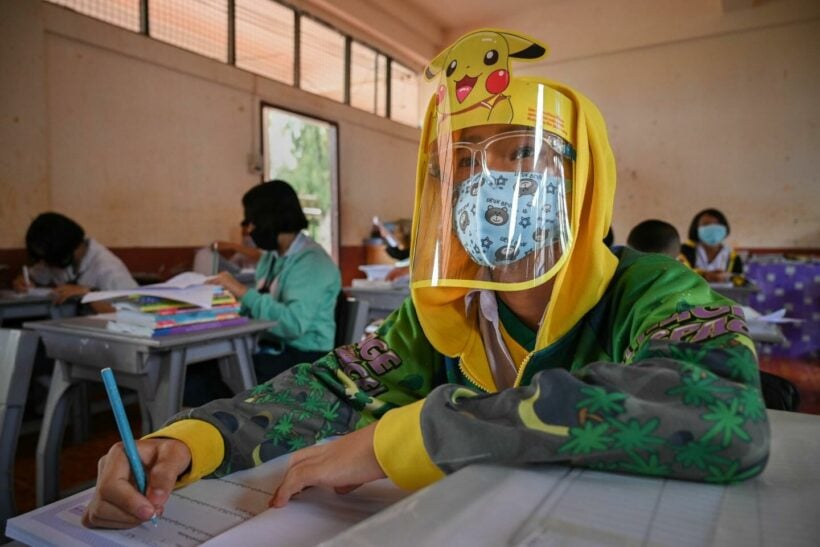Thailand’s English proficiency level drops again, as the pandemic widens gap in education disparity

Thailand is continuing its downward descent for the 5th straight year in regards to its English proficiency levels. According to the Swedish company, Education First, Thailand is now ranked 100 out of 112 participating countries for its English proficiency levels.
Its EF EPI score of 419 and its ranking of 22 out of 24 overall in Asian countries, has deemed Thailand to be that of a “very low” English proficiency level. This level, according to the organisation, explains that the average adult in Thailand is able to:
-Introduce oneself simply (name, age, country of origin)
-Understand simple signs
-Give basic directions to a foreign visitor
The news of Thailand’s poor English language skills is not new, and for years, people have blamed the government for its lack of modernising teaching methods and curriculum.
Many critics also say that Thailand’s education system is long-outdated as it focuses on rote learning methods, which essentially mean memorising facts and figures, rather than applying them. Focusing on language accuracy over the sheer act of trying to converse in English, has been cited as another hurdle in the country’s population advancing its English skills. Critics of the education system say these 2 factors are the most important in preventing the average adult from being able to converse effectively in English.
A widening education disparity gap
But, English proficiency levels are not the only thing that is lacking in the country, as education overall features a widening disparity gap between the rich and poor. Now, as the Covid-19 pandemic has thrust the country’s education disparities into the limelight, critics say the government, civil society, and the private sector will need to act fast and boldly to minimise the damage to students who have largely been studying online since schools were shuttered during the pandemic.
Clearly, the pandemic’s health implications should come first, as the government should listen to doctors and public health experts. But, the fallout from the pandemic sees the education as coming in at a close 2nd place to the effects of the pandemic.
The pandemic has seen thousands more students that have sought financial help this year, with the education gap growing between the rich and poor. With some families not being able to afford to send their children to school due to financial stress brought on by the pandemic, it has left many students behind.
Around 1.8 million students have applied for financial aid this year, a number that is up from 1.56 million last year, totalling a 17.5% increase. And, 20% of those families that applied are considered extremely impoverished. Chaiyuth Punyasavatsut, the fund’s chief, says the number of extremely impoverished applicants has risen from 300,000 to 600,000 this year. He says some families have been tasked with coming up with tuition fees that are 3 to 4 times higher than their income, just to send their children to higher classes.
“It can be confirmed that Covid-19 has worsened the economic situation and educational gap. More children are slipping through the system due to high tuition fees.”
According to the World Bank, povery rates in Thailand from 2015 to 2018, grew 2.6%. So, the number of people living in poverty increased from 4.85 million to more than 6.7 million people. The organisation also pointed towards the education disparity as having a large impact on Thailand’s youth.
“A Thai child born today can expect to obtain 12.4 years of schooling before the age of 18. However, once adjusted for quality of learning, that only amounts to 8.6 years of schooling, indicating a gap of 3.8 years.”
Thailand isn’t the only country dealing with a disruption to its education systems, as it is evident in every country worldwide. The Kenan Foundation Asia has identified 3 potential consequences in Thai education that need to be addressed, that have stemmed from the pandemic.
Widening educational inequality
As students at wealthy, international schools and prestigious public schools in Bangkok, will likely have the e-learning tools necessary to take the Covid disruption into nothing more than minor speed bump, their peers in rural areas may not be so lucky. As many Thai students do not own laptops, the online learning has proven difficult.
Additionally, parents of underprivileged students work disproportionately in “essential” jobs, or low-wage jobs that are likely be among the first eliminated as businesses move to cut costs. Given the precarious situation, these parents don’t have the time to fill in as their child’s temporary teacher nor the financial resources to afford outside support.
Reinforcing ineffective teaching practices
All nations need to accept that things may not return to normal as quickly as they hope and plan accordingly. In education, policymakers need to consider remote learning options when in-person instruction may not be possible. Unfortunately, Thailand is not prepared to deliver e-learning effectively. Few Thai teachers have received training on using technology for remote learning, and many students, especially in rural areas, lack the technology necessary to enable equitable e-learning. Although the Ministry of Education is considering the distribution of tablets to educators and students in need, this solution is only 1 step towards providing quality education to all students.
The issue with distributing tablets in isolation is that it may serve to reinforce bad teaching practices like rote learning. If teachers lack training and experience in leading online classrooms, then they tend to fall back on outdated, one-way teaching practices. For example, a lesson may consist of a lecture that offers students little to no opportunity to engage actively with the materials. This type of learning is not only dull, it’s also ineffective.
Poor teacher support
We all know teachers are underpaid yet contribute immensely to our overall wellbeing. The pandemic could magnify the insufficient support that society provides to teachers if we are not vigilant. For example, a sudden shift to online learning without direction from school leaders is likely to lead to teachers feeling alienated, confused, and out of control. You cannot simply hand a teacher a laptop and say, ‘teach chemistry.’ We have to understand that the pandemic changes the way teachers give lessons, assess student learning, help struggling students, etc.
An opportunity for change
With disruption comes opportunity. An outdated, memorisation-based education model has constrained the development of Thai students for decades. Yet the pandemic has positioned Thailand’s education to be at a fork in the road. We can choose to either stay the traditional course of rote learning, or embrace 21st-century learning. If we want the latter, the first leap into the future will be empowering each teacher to become an oasis of high-impact learning.
To take that step, Thailand must support teachers by providing them with the training, learning materials, and the technology necessary to effectively deliver 21st-century education. Teachers themselves will need to become students to adapt to the new paradigm of blended learning (the combination of online and classroom instruction), and, most importantly, master high-impact teaching practices, such as inquiry and project-based learning, that enable students to engage actively with materials, ask questions, and find their own solutions to problems.
This hands-on approach is the key to developing students with the 21st-century skills that Thailand urgently needs to drive the country forward. Yet, Thai culture deems that no questions be asked to those in a higher class, such as teachers. The classroom environment is set up to enable rote learning, with students feeling threatened to question their teacher.
Thailand is one of the most unequal societies in the world
And, it’s not just education that is unequal in Thailand. As a Credit Suisse report named Thailand the most unequal country in the world in recent years, it noted that just 1 percent of the population owned 66.9% of the nation’s wealth.
Decharut Sukkumnoed, an economics professor at Kasetsart University, said at the root of social disparity in Thailand was insufficient and poor-quality welfare as well as unequal access to state welfare among citizens.
“Many poor people are unable to pursue their goals and improve their livelihoods because they do not get enough assistance from authorities to get good education, which is an important foundation in life.”
“Meanwhile, many middle-class people are also facing financial problems as they have to rely on expensive education and healthcare services from the private sector, because the quality of state welfare is poor.”
Increased educational funding has made little difference
This was reiterated by United States-based non-profit organisation, the Borgen Project on its official website where it noted that while the government had spent 19.4% of its yearly budget on education in 2015 – the largest allocation for any one particular sector – Thailand was yet to see cumulative improvements in its schools.
“The lack of success might be the result of poorly-divided funds. Instead of distributing it equally, the government funnels a large proportion of money toward schools where students already have a high likelihood to succeed and gives less to smaller and more rural schools.”
As a result, schools in poor areas end up stretching their resources too thin, resulting in individual teachers often teaching multiple grades and subjects. Due to these inequalities, students in city schools historically demonstrate higher rates of improvement compared to those in rural schools.
The Borgen Project also noted that while funding inequality puts small, rural schools at a particular disadvantage, the outdated curriculum, indeed, does a disservice to all Thai schools.
But the ones suffering the most from receiving a poor-quality education – and lower English proficiency levels – are those unable to afford good quality education in Thailand where education inequality is still rampant.
The circle of Thailand’s elite
Stephen Holroyd, the principal of Shrewsbury International School in Bangkok, found that elite schools continue to send their most affluent students to expensive Oxbridge and Ivy League universities in the United Kingdom and the US.
He says these internationally-educated students, in turn, are better positioned to get top jobs in Thailand, not only because of the quality education that they accessed, but also by networking with other elite foreign university students in Thailand.
As the pandemic continues to see many of Thailand’s government-funded schools staying shuttered, the effects of its youth’s education can only be hypothesized, based upon the existing factors that have affected the country for years.
Latest Thailand News
Follow The Thaiger on Google News:


























